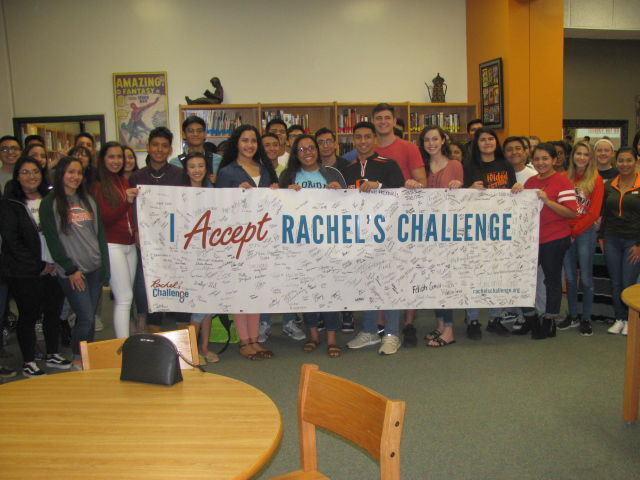HARLINGEN — When Anell McDaniel takes her seat in physics class, she doesn’t just focus on her own little world. She speaks to the quiet boy in the next row.
When she walks down the halls of Harlingen High School South, she says hello to students she doesn’t know.
“Rachel’s Challenge talks about opening up to different relationships with people around us,” said Anell, 16, a junior.
Harlingen South just started its “Rachel’s Challenge” program this month.
Rachel’s Challenge is a nationwide program aimed at promoting safer schools. It’s named after Rachel Scott, one of the students killed at Columbine High School in 1999.
“She was very specific about how one act of kindness could turn into multiple acts of kindness,” said Principal Fernando Reyes.
The program began just a few weeks ago, said Tracy Hitchcock, instructional coach and director of Rachel’s Challenge at South. It started with a training session in which about 100 students learned about the different programs and how to implement them.
Part of the Challenge was the formation of the Friends of Rachel Club, of which Anell is a member.
She pointed out that while South students are very kind and engaged in all sorts of community service projects, there’s always room to grow.
“In the hallways and classrooms we are very quiet,” she said. “We are trying to extend ourselves to students we never would have if not for Rachel’s Challenge.”
She and other students have impressed Hitchcock with their proactive approach.
“They have different lessons they’ve been doing in the classroom,” she said. “We talk about dealing with some issues like bullying, cyber bullying.”
Rachel Scott’s final essay speaks to the mission of her Challenge very well.
“I have this theory that if one person can go out of their way to show compassion, then it will start a chain reaction of the same. People will never know how far a little kindness can go.”
The message seems to be spreading. One of the programs being implemented as part of Rachel’s Challenge is handing out random notes of kindness.
“We’re putting notes on the lockers,” said Mia Medrano, a member of the Friends of Rachel Club.
But it’s not just that club that’s handing out notes.
“I think JROTC is doing it,” said Mia, 18. “I had a note on my car that said, ‘I hope you have the best year ever.’”
Reyes said it’s helping create balance in the school curriculum.
“It’s really helping us with character building,” he said. “It’s a school-imbedded curriculum in which students learn lessons about being kind and showing character when in front of people and when no one’s around.”
Rachel’s Challenge programs provide a sustainable, evidence-based framework for positive climate and culture in our schools. Fully implemented, partner schools achieve statistically significant gains in community engagement, faculty/student relationships, leadership potential, and school climate; along with reductions in bullying, alcohol, tobacco and other drug use.
Every year:
– More than 1.5 million people are involved in Rachel’s Challenge programs.
– More than 1,200 schools and businesses are reached.
– More than 150 suicides are averted.
– Bullying and violence decrease.
– Community service and acts of kindness increase.
Today, Rachel’s Challenge exists to inspire and equip every person to create a permanent positive change not only in themselves, but in their schools, their businesses and communities. We have a comprehensive set of age-appropriate programs for K-12, college and business. The objectives of these programs are all the same; to continue Rachel’s legacy of kindness and compassion and to:
– Help schools and businesses become safer, more connected places to live and learn.
– Stimulate real culture change by actively involving the entire community in the process.
– Change lives by providing culturally relevant social/emotional training.
– Increase achievement and ensure results by engaging the participants’ heart, head and hands in a continuing improvement process.
Source: rachelschallenge.org




